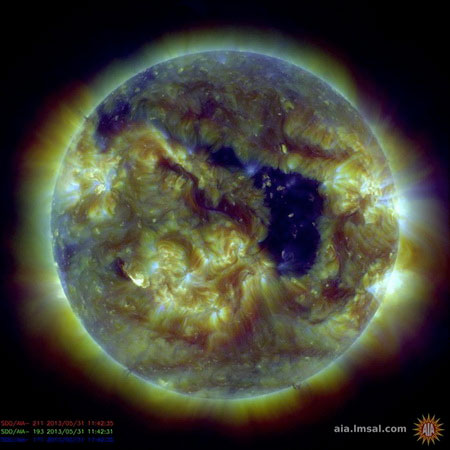The sun ripped a huge hole
Scientists at the US Aerospace Agency (NASA) on June 5 reported finding a giant flower hole in the Sun when this part of the Sun turned to Earth last week.

Sun flower hole through NASA photos - (Photo: NASA)
Flower holes are areas where the sun is darker, matter concentrates less and is relatively cooler than plasma bodies on the surface of our nearest star. The corona is the source of the solar wind that carries matter particles from the Sun from the Earth's atmosphere, causing aurora (and less spectacular, magnetic storms) on Earth.
When the flower holes are taken through ultraviolet images, they appear as black dots but with the human eye are holes in the plasma.
Last week, from May 28 to May 31, one of the giant flower holes turned to Earth.'That's one of the biggest holes we've seen in a year' - according to NASA.
However, this phenomenon has almost no effect on life on Earth. The solar wind from the Japanese hole usually takes two or three days to reach our planet, so we may have experienced weather changes (if any) caused by this hole.
- Video: The moment the super black hole ripped and swallowed a star
- Detecting huge hollow black holes in the universe
- Scientists split about the huge gap that appeared in Antarctica
- The painful death of a star ripped apart by a supermassive black hole
- Capture the scene of the black hole
- Huge black hole strayed in the galaxy
- The mysterious death hole appeared in Russia
- Huge black hole swallowed the stars
- Reveal the mysterious black hole on the Martian crater
- Detecting huge black holes revealing the universe at the age of cradle
- Discovering 'super black holes' is 12 times bigger than the Sun.
- 740 million light years away is a completely different universe of black holes
 Van Allen's belt and evidence that the Apollo 11 mission to the Moon was myth
Van Allen's belt and evidence that the Apollo 11 mission to the Moon was myth The levels of civilization in the universe (Kardashev scale)
The levels of civilization in the universe (Kardashev scale) Today Mars, the sun and the Earth are aligned
Today Mars, the sun and the Earth are aligned The Amazon owner announced a secret plan to build a space base for thousands of people
The Amazon owner announced a secret plan to build a space base for thousands of people